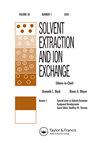溶剂萃取-选择性沉淀法从模拟纳滤海水淡化盐水中回收锂
IF 2.1
4区 化学
Q3 CHEMISTRY, MULTIDISCIPLINARY
引用次数: 2
摘要
摘要世界海洋中含有大量的锂,但由于锂的浓度较低,溶剂萃取无法回收锂。相比之下,海水淡化盐水经过纳滤处理后,其锂浓度大约是原海水的十倍。因此,可以使用溶剂萃取从这样的流中有效地回收锂。与其他从稀溶液中螯合锂的技术相比,溶剂萃取具有操作简单、技术稳健、回收率高的优点。因此,我们提出了一种基于溶剂提取的工艺,通过纳滤处理从海水淡化盐水中回收锂。第一步包括使用对-辛烯中的新癸酸甲基三辛基铵除去镁和钙。随后使用Shellsol D70稀释剂中的萃取剂Mextral 54–100和Cyanex 923进行锂萃取步骤。然后用水洗涤锂提取物并用盐酸汽提。随后,用氢氧化钠在乙醇中除去残留的碱土金属,最后用碳酸钠沉淀锂。溶剂萃取、洗涤和汽提步骤在小型中试规模上以连续逆流模式(在混合沉降器中)进行了演示,而沉淀步骤则在分批中进行了演示。发现该方法的总产率为74%,得到纯度为97的碳酸锂产品 重量%。本文章由计算机程序翻译,如有差异,请以英文原文为准。
Recovery of Lithium from Simulated Nanofiltration-Treated Seawater Desalination Brine Using Solvent Extraction and Selective Precipitation
ABSTRACT The world's seas and oceans contain vast amounts of lithium, but the low concentration hereof renders solvent extraction impractical for its recovery. By contrast, seawater desalination brine, after treatment by nanofiltration, contains a roughly tenfold greater concentration of lithium than raw seawater. Hence, lithium can be effectively recovered from such streams using solvent extaction. Compared with other techniques to sequester lithium from dilute solutions, solvent extraction offers the advantages of simple operations, robust and well-established technology and high recovery yields. Thus, we propose a solvent-extraction based process to recover lithium from seawater desalination brine, treated by nanofiltration. The first step comprises the removal of magnesium and calcium using methyltrioctylammonium neodecanoate in p-cymene. This is followed by a lithium extraction step using the extractants Mextral 54–100 and Cyanex 923 in Shellsol D70 diluent. The lithium extract is then scrubbed with water and stripped with hydrochloric acid. Subsequently, residual alkaline earth metals are removed with sodium hydroxide in ethanol and finally lithium is precipitated using sodium carbonate. The solvent extraction, scrubbing and stripping steps were demonstrated on mini-pilot scale in continuous countercurrent mode (in mixer-settlers), while the precipitation steps were demonstrated in batch. The process was found to have an overall yield of 74%, affording a lithium carbonate product with a purity of 97 wt%.
求助全文
通过发布文献求助,成功后即可免费获取论文全文。
去求助
来源期刊
CiteScore
4.40
自引率
5.00%
发文量
15
审稿时长
8.4 months
期刊介绍:
Solvent Extraction and Ion Exchange is an international journal that publishes original research papers, reviews, and notes that address all aspects of solvent extraction, ion exchange, and closely related methods involving, for example, liquid membranes, extraction chromatography, supercritical fluids, ionic liquids, microfluidics, and adsorption. We welcome submissions that look at: The underlying principles in solvent extraction and ion exchange; Solvent extraction and ion exchange process development; New materials or reagents, their syntheses and properties; Computational methods of molecular design and simulation; Advances in equipment, fluid dynamics, and engineering; Interfacial phenomena, kinetics, and coalescence; Spectroscopic and diffraction analysis of structure and dynamics; Host-guest chemistry, ion receptors, and molecular recognition.

 求助内容:
求助内容: 应助结果提醒方式:
应助结果提醒方式:


